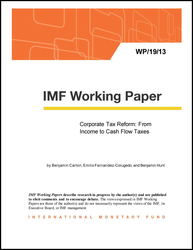
Corporate Tax Reform: From Income to Cash Flow Taxes
This paper uses a multi-region, forward-looking, DSGE model to estimate the macroeconomic impact of a tax reform that replaces a corporate income tax (CIT) with a destination-based cash-flow tax (DBCFT). Two key channels are at play. The first channel is the shift from an income tax to a cash-flow tax. This channel induces the corporate sector to invest more, boosting long-run potential output, GDP and consumption, but crowding out consumption in the short run as households save to build up the capital stock. The second channel is the shift from a taxable base that comprises domestic and foreign revenues, to one where only domestic revenues enter. This leads to an appreciation of the currency to offset the competitiveness boost afforded by the tax and maintain domestic investment-saving equilibrium. The paper demonstrates that spillover effects from the tax reform are positive in the long run as other countries’ exports benefit from additional investment in the country undertaking the reform and other countries’ domestic demand benefits from improved terms of trade. The paper also shows that there are substantial benefits when all countries undertake the reform. Finally, the paper demonstrates that in the presence of financial frictions, corporate debt declines under the tax reform as firms are no longer able to deduct interest expenses from their profits. In this case, the tax shifting results in an increase in the corporate risk premia, a near-term decline in output, and a smaller long-run increase in GDP.
Publication date: January 2019
ISBN: 9781484390085
$18.00
Add to Cart by clicking price of the language and format you'd like to purchase
Available Languages and Formats
| English |
Prices in red indicate formats that are not yet available but are forthcoming.
Topics covered in this book
This title contains information about the following subjects.
Click on a subject if you would like to see other titles with the same subjects.
tax policy , business taxation , corporate leverage , dynamic stochastic general equilibrium models , macroeconomic interdependence , tax policy , business taxation , dynamic stochastic general equilibrium models , macroeconomic interdependence , Forecasting and S
Also of interest
Summary
Copyright © 2010 - 2025
Powered by:
AIDC



